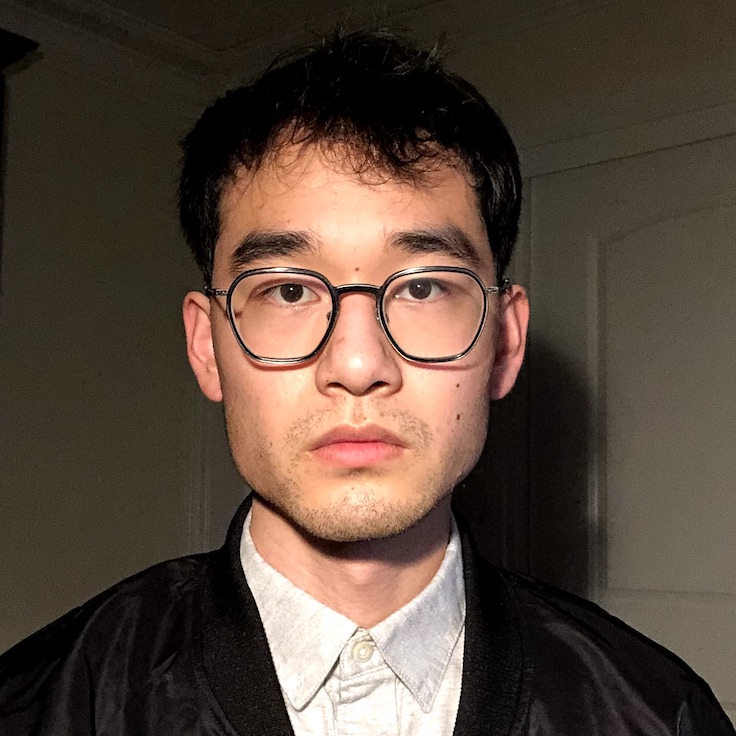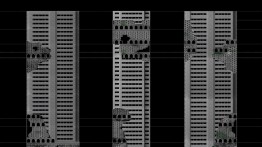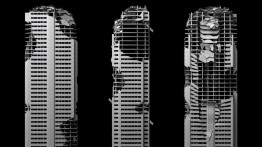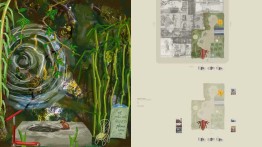Senior Snapshots: Architecture 2022
POSTED ON: May 18, 2022
In this second installment of our 2022 Senior Snapshot series, Kevin Chow, Maria Eleni Komninou, and Sanjana Lahiri, three fifth-year students from The Irwin S. Chanin School of Architecture, reflect on their time at Cooper.
 Hailing from Saratoga, California, Kevin Chow knew about Cooper because he had an art teacher who always talked about the school with reverence. After doing some research, Kevin decided that the teacher, a printmaker who taught classes in drawing, had good reason for fixating on Cooper. The problem was he didn’t think art was necessarily the direction he wanted to take, since the gallery system of showing work struck him as too insular. Anyway, he was more interested in the architecture school: the second volume of Education of an Architect as well as the conceptual and pedagogical work of John Hejduk, the school's founding dean.
Hailing from Saratoga, California, Kevin Chow knew about Cooper because he had an art teacher who always talked about the school with reverence. After doing some research, Kevin decided that the teacher, a printmaker who taught classes in drawing, had good reason for fixating on Cooper. The problem was he didn’t think art was necessarily the direction he wanted to take, since the gallery system of showing work struck him as too insular. Anyway, he was more interested in the architecture school: the second volume of Education of an Architect as well as the conceptual and pedagogical work of John Hejduk, the school's founding dean.
Yet during his years at Cooper, he couldn’t help but feel that, with the absence of legendary professors at Cooper like the late Diane Lewis and Lebbeus Woods, he had arrived at Cooper after a “golden age.” Still, he was impressed with the many ways that Dean Nader Tehrani actively encouraged a healthy criticism of all aspects of education. Taking that to heart, Kevin served on a number of committees that dealt with the architecture and humanities curriculums, architecture school admissions, and other collegiate issues. And learning from other students in the big studio—an essential element of a Cooper architecture education still very much intact—has kept him sharp. As an example, he recalls the time during his first year that a thesis student made an insightful (though painfully blunt) criticism about his project, noting ways that Kevin’s work could —and should—be better. It was midnight and the work was due in the morning, but he revised the work, motivated by the older student’s remarks and her assumption that your work must be a source of pride.
Kevin’s thesis project considers the consequences of separating the physical from the psychic, a long tradition in Western thought that has had its latest iteration in approaches to artificial intelligence. For his project, entitled “Soul-Searching or the Simulation to Evaluate the First Digital Mind,” he wrote a work of science fiction that, for his mid-semester review, required his critics to read a script, a strategy to convey his ideas and also subvert the usual review practice. The story provokes thoughts about how we define “soul” and how robotics and artificial intelligence can or can’t approximate human-ness. “The narrative is designed to demonstrate and problematize the transformation of the biological subject into the digital.”
In the fall, Kevin will continue his studies at the School of Architecture at Princeton and then plans to take a position at a firm where he can wrestle with the everyday problems of getting a project built. “Being a practicing architecture will erode certain idealism,” he says, but like his thesis project contends with, he’s interested exactly in how theory and concept transform when brought into real life.
When Maria Eleni Komninou discovered she had gotten into The Irwin S. Chanin School of Architecture five years ago, she accepted immediately. A guidance counselor had mentioned Cooper to her less than a year before, but from the start, she had her heart set on the school. A native of Athens, Greece, she had traveled to New York several times so she thought she had a fairly clear idea of where she was going, but that first year was tough. The demands of the architecture program were legion, more than she’d anticipated. As a result, though, she and her classmates grew close, supporting each other and becoming highly familiar with each other’s projects. “We’re at the point that we can give each other a lot of useful feedback. Cooper helped all of us in that sector because our professors have so much knowledge of the field and in theory that listening to them speak and critique us, we gained the ability to do it ourselves.”
Maria Eleni spent the worst months of the COVID pandemic back home in Athens. The time difference proved challenging for her and many other Cooper students who were living in different time zones from New York. “I used to do my homework in the morning and have class at 2 AM. I think the weirdest part was not being at Cooper and basically being in a space alone. We were scattered all over the world.” Work was done digitally—drawings and videos, but she found that this method was lacking compared to in-person discussions usually where critics could see all the work laid out together and make comments or revisions directly on her drawings. “There’s an immediacy to it. I’m very happy that Cooper is back in person for this final year.” Post-COVID, she finds that people spend slightly less time in the studio compared to her first years, and feels her class’s work-life balance is healthier now.
For her thesis project, entitled "Reassembling Beirut," Maria Eleni focused on new ways and new materials that could be used to create elements as infill for buildings that were destroyed during the tragic 2020 explosion there, which resulted from the storage of ammonium nitrate at the city’s port. Her proposal called for using some of the debris from the blast and casting it in wax or resin to create different forms, though initially she had imagined them as bricks. The shapes of these elements would be determined in what she calls “community labs,” places where citizens could meet to work with materials as a means for healing after the extraordinary trauma, which left at least 217 people dead. In her drawings, Maria Eleni showed arches being made from this composite material since arches are a common form in the city, rotating them to give them multiple uses. “You’re taking elements from one area and putting them into another.” She learned to refine her project from suggestions made during reviews: how could a tactile system like this be systematized? Who would fund the project?
She plans to work in a corporate architecture firm in New York to gain experience in the field. “I don’t want to be an architect that only draws,” she says, and to that end wants to learn the specifics of strategizing for large projects and structuring their funding. After a few years working, she plans to earn an MBA.
 For Sanjana Lahiri, participation in the Cooper Climate Coalition has helped shape her education. “It’s been a really key part of my work, which has been oriented towards questions about climate.”
For Sanjana Lahiri, participation in the Cooper Climate Coalition has helped shape her education. “It’s been a really key part of my work, which has been oriented towards questions about climate.”
The results of her commitment to combat climate change and inequality have been many and far-reaching. In 2021, Sanjana helped design a course with Alisa Petrosova A’21 in the Faculty of Humanities and Social Sciences taught by Kit Nicholls, the director of the Center for Writing. The course, entitled “Climate, Culture, and Society” covered climate change as a political, social, and cultural process.
Sanjana, who grew up in Singapore, also designed an independent study with her fellow student, Annabella Chen, and supervised by Professor Elisa Iturbe, Ryan Ludwig, and Caitlin Watson. The project centers on climate legislation related to New York City housing with the goal of mitigating environmental damage while preventing further privatization of public housing. She and Annabella started the Cooper chapter of The Architecture Lobby, an international group that advocates for the value of architecture, acknowledgement of labor as central to the practice of architecture, and the rights of workers, among other tenets. And as a curator of the school’s student lecture series in her fourth year, she brought guests to campus including Cave Bureau, Feifei Zhou, Anooradha Iyer Siddiqi, and Caitlin Taylor.
Due to the COVID pandemic, Sanjana returned to Singapore halfway through her third year of architecture school, and continued courses online. Her architectural investigations continued, and the following year she produced a project entitled “Kashmir: Images of Sovereignty, Projections of Desire,” which attempted to contend with the Indian occupation of Kashmir as something that is actively, and incessantly, enacted upon both the landscapes and the bodies of the territory in question. Professor Farzin Lotfi-Jam called the result one of “the most brilliant projects I have seen…. It is immensely intelligent, richly visualized, thoroughly detailed, and a rally for the discipline of architecture to imagine more justly. At a time in which we are all thinking about structural inequalities and histories of violence, Sanjana’s project reckons with our discipline’s colonial legacies and starts to speculate and offer new and more equitable forms of practice.”
For her thesis year, Sanjana has been researching the role of New York City’s community gardens as sites that act as spaces of resistance, while simultaneously being co-opted by the very systems of real estate they are resisting. “Community gardens are a strange type of public space,” she says. “Technically they’re owned by the city but leased and licensed to a small group of gardeners. They’re somewhere between the scales of a backyard and a park, and stewarded by volunteers rather than city officials. I’m looking at trespassing and the formation of gardens, which can act as forms of direct action in a world where private property is intrinsically linked to is a form of power.”
Her project, “Taking Space,” includes research on the Liz Christy Garden on Houston Street, an early, still-functioning community garden founded in 1973 as well as the Esperanza Garden on 8th Street, which was demolished in favor of a housing development. Sanjana’s research pointed to the history of gardens as extremely precarious spaces that, when not commodified, were constantly at risk of demolition.
Her site of intervention was the 10th Street Garden, between Avenues B and C, which was demolished to make way for residential buildings that, to date, were not constructed. Her proposal for the re-appropriation of this currently vacant space involved both small-scale direct action by the surrounding community, as well as a study of federal legislation that would grant protection to precarious community spaces.
After graduation, she will work as curatorial intern for Professor Lydia Kallipoliti, who is the curator of the Tallinn Biennale. In the long term, Sanjana plans to work in the realm of climate action with, as she recently put it, “one foot in design.”










